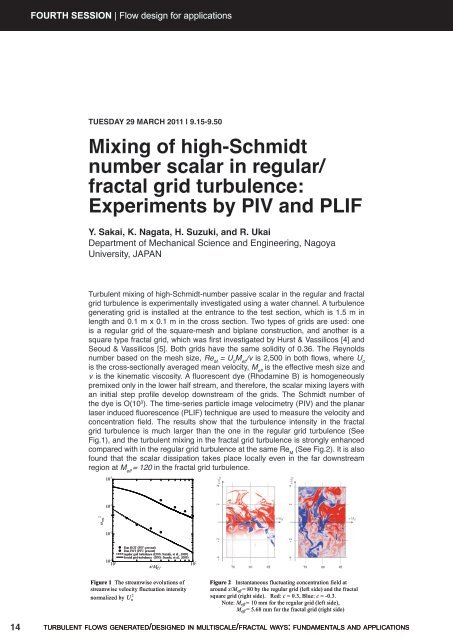Turbulent flows generated/designed in multiscale/fractal ... - Ercoftac
Turbulent flows generated/designed in multiscale/fractal ... - Ercoftac
Turbulent flows generated/designed in multiscale/fractal ... - Ercoftac
You also want an ePaper? Increase the reach of your titles
YUMPU automatically turns print PDFs into web optimized ePapers that Google loves.
FOURTH session | Flow design for applications<br />
Flow design for applications | FOURTH session<br />
TUESDAY 29 MARCH 2011 | 9.15-9.50<br />
Mix<strong>in</strong>g of high-Schmidt<br />
number scalar <strong>in</strong> regular/<br />
<strong>fractal</strong> grid turbulence:<br />
Experiments by PIV and PLIF<br />
Y. Sakai, K. Nagata, H. Suzuki, and R. Ukai<br />
Department of Mechanical Science and Eng<strong>in</strong>eer<strong>in</strong>g, Nagoya<br />
University, Japan<br />
<strong>Turbulent</strong> mix<strong>in</strong>g of high-Schmidt-number passive scalar <strong>in</strong> the regular and <strong>fractal</strong><br />
grid turbulence is experimentally <strong>in</strong>vestigated us<strong>in</strong>g a water channel. A turbulence<br />
generat<strong>in</strong>g grid is <strong>in</strong>stalled at the entrance to the test section, which is 1.5 m <strong>in</strong><br />
length and 0.1 m x 0.1 m <strong>in</strong> the cross section. Two types of grids are used: one<br />
is a regular grid of the square-mesh and biplane construction, and another is a<br />
square type <strong>fractal</strong> grid, which was first <strong>in</strong>vestigated by Hurst & Vassilicos [4] and<br />
Seoud & Vassilicos [5]. Both grids have the same solidity of 0.36. The Reynolds<br />
number based on the mesh size, Re M<br />
= U 0<br />
M eff<br />
/ν is 2,500 <strong>in</strong> both <strong>flows</strong>, where U 0<br />
is the cross-sectionally averaged mean velocity, M eff<br />
is the effective mesh size and<br />
ν is the k<strong>in</strong>ematic viscosity. A fluorescent dye (Rhodam<strong>in</strong>e B) is homogeneously<br />
premixed only <strong>in</strong> the lower half stream, and therefore, the scalar mix<strong>in</strong>g layers with<br />
an <strong>in</strong>itial step profile develop downstream of the grids. The Schmidt number of<br />
the dye is O(10 3 ). The time-series particle image velocimetry (PIV) and the planar<br />
laser <strong>in</strong>duced fluorescence (PLIF) technique are used to measure the velocity and<br />
concentration field. The results show that the turbulence <strong>in</strong>tensity <strong>in</strong> the <strong>fractal</strong><br />
grid turbulence is much larger than the one <strong>in</strong> the regular grid turbulence (See<br />
Fig.1), and the turbulent mix<strong>in</strong>g <strong>in</strong> the <strong>fractal</strong> grid turbulence is strongly enhanced<br />
compared with <strong>in</strong> the regular grid turbulence at the same Re M<br />
(See Fig.2). It is also<br />
found that the scalar dissipation takes place locally even <strong>in</strong> the far downstream<br />
region at M eff<br />
= 120 <strong>in</strong> the <strong>fractal</strong> grid turbulence.<br />
TUESDAY 29 MARCH 2011 | 9.50-10.25<br />
Aero-acoustic<br />
performance of<br />
<strong>fractal</strong> spoilers<br />
J. Nedic, B. Ganapathisubramani, J.C. Vassilicos<br />
Department of Aeronautics, Imperial College London, UK<br />
J. Boree, L.E. Brizzi, A. Spohn<br />
Institut P’, CNRS • ENSMA • Universite de Poitiers, FRANCE<br />
One of the major environmental problems fac<strong>in</strong>g the aviation <strong>in</strong>dustry is that of<br />
aircraft noise. The work presented here, done as part of the EU’s OPENAIR Project,<br />
looks at reduc<strong>in</strong>g spoiler noise whilst ma<strong>in</strong>ta<strong>in</strong><strong>in</strong>g lift and drag characteristics<br />
through means of large-scale <strong>fractal</strong> porosity. It is hypothesised that the highly<br />
turbulent flow <strong>generated</strong> by <strong>fractal</strong> grids, which have multiple-length-scales, would<br />
reduce the impact of the re-circulation region and with it, the low frequency noise<br />
it generates. In its place, a higher frequency noise is <strong>in</strong>troduced which is more<br />
susceptible to atmospheric attenuation and could be deemed less offensive to<br />
the human ear. A total of n<strong>in</strong>e laboratory scaled spoilers were looked at, seven<br />
of which had a <strong>fractal</strong> design, one with a regular grid design and one solid for<br />
reference. The spoilers were <strong>in</strong>cl<strong>in</strong>ed at an angle of 30 o . Force, acoustic and flow<br />
visualisation experiments on a flat plate were carried out, where it was found that<br />
the present <strong>fractal</strong> spoilers reduce the low frequency noise by 2.5dB. Results show<br />
that it is possible to improve the acoustic performance by modify<strong>in</strong>g a number of<br />
parameters def<strong>in</strong><strong>in</strong>g the <strong>fractal</strong> spoiler, some of them very sensitively. From these<br />
experiments, two <strong>fractal</strong> spoilers were chosen for a detailed aero-acoustic study on<br />
a three-element w<strong>in</strong>g system, where it was found that the <strong>fractal</strong> spoilers had a 1dB<br />
reduction <strong>in</strong> the sound pressure level and were also able to ma<strong>in</strong>ta<strong>in</strong> the amount of<br />
lift and drag <strong>generated</strong> by the w<strong>in</strong>g system.<br />
Figure 1 The streamwise evolutions of<br />
streamwise velocity fluctuation <strong>in</strong>tensity<br />
normalized by<br />
Figure 2 Instantaneous fluctuat<strong>in</strong>g concentration field at<br />
around x/M eff = 80 by the regular grid (left side) and the <strong>fractal</strong><br />
square grid (right side). Red: c = 0.3, Blue: c = -0.3.<br />
Note: M eff = 10 mm for the regular grid (left side),<br />
M eff = 5.68 mm for the <strong>fractal</strong> grid (right side)<br />
14 turbulent <strong>flows</strong> <strong>generated</strong>/<strong>designed</strong> <strong>in</strong> <strong>multiscale</strong>/<strong>fractal</strong> ways: fundamentals and applications<br />
turbulent <strong>flows</strong> <strong>generated</strong>/<strong>designed</strong> <strong>in</strong> <strong>multiscale</strong>/<strong>fractal</strong> ways: fundamentals and applications 15

















